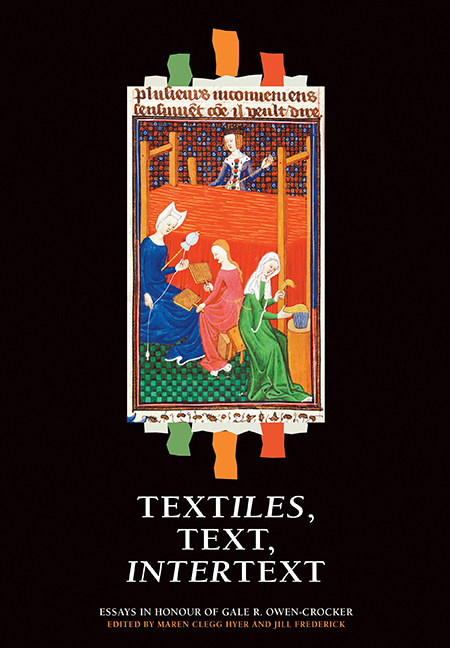Book contents
- Frontmatter
- Contents
- List of Illustrations
- List of Abbreviations
- Introduction
- A Personal Recollection
- List of publications of Gale R. Owen Crocker
- Part I Textile
- 1 The Language of Dress and Textiles in Wills of the Old English Period
- 2 Opus What? The Textual History of Medieval Embroidery Terms and Their Relationship to the Surviving Embroideries c. 800–1400
- 3 Intertextuality in the Bayeux Tapestry: The Form and Function of Dress and Clothing
- 4 Birds of a Feather: Magpies in the Bayeux Tapestry?
- 5 Threads and Needles: The Use of Textiles for Medical Purposes
- Part II Text
- Part III Intertext
- Index
- Tabula Gratulatoria
4 - Birds of a Feather: Magpies in the Bayeux Tapestry?
from Part I - Textile
Published online by Cambridge University Press: 05 July 2016
- Frontmatter
- Contents
- List of Illustrations
- List of Abbreviations
- Introduction
- A Personal Recollection
- List of publications of Gale R. Owen Crocker
- Part I Textile
- 1 The Language of Dress and Textiles in Wills of the Old English Period
- 2 Opus What? The Textual History of Medieval Embroidery Terms and Their Relationship to the Surviving Embroideries c. 800–1400
- 3 Intertextuality in the Bayeux Tapestry: The Form and Function of Dress and Clothing
- 4 Birds of a Feather: Magpies in the Bayeux Tapestry?
- 5 Threads and Needles: The Use of Textiles for Medical Purposes
- Part II Text
- Part III Intertext
- Index
- Tabula Gratulatoria
Summary
The Bayeux Tapestry is alive with birds; in her 2005 article, “Squawk Talk: Commentary by Birds in the Bayeux Tapestry”, Gale R. Owen-Crocker counts 217 of them. The roles these birds play are richly varied: not only as hunting hawks and ornamental finials in the main register, but far more numerously in the borders, as actors in fables, and as what Owen-Crocker considers decorative pairs and singletons, which she sees also as sometimes commenting by pose and expression on the narrative action of the main register. Some of these birds are recognizable species: doves, peacocks, roosters, hawks or eagles, storks, cranes or herons; other less convincing identifications have included an ostrich, an owl, and paired phoenixes. Many of these species carry one or more widely applied symbolic associations in medieval art.
Among the birds in the border, there is a consistent tendency, regardless of physical type, to show the wings in a contrasting color and often to delineate the pinfeathers as alternating colors, creating a pattern of stripes. The colors used for the birds reflect the palette of the Tapestry as a whole, including dark green, red, gold, and black: naturalistic color is not intended. In part, the use of unnaturally bright colors for the birds and the contrasting color for the wings is probably intended to help make the bird and its pose visually legible. If the Tapestry was made for display in a large space such as a hall or church, as has been widely suggested, the color differences would certainly have enhanced visual legibility at a distance. However, the contrasting wing color of some of the birds in the Tapestry's borders may have an additional dimension of symbolic content. Of the birds of northwestern Europe, the most widespread example of a bird with a starkly contrasting wing is the magpie, with a highly striking white shoulder patch and stomach displayed against a black body. Given the non-naturalistic colors of the Tapestry's avian population, an accurate observation of color and its placement is not to be hoped for. But other elements of magpie appearance and behavior may be present here, thereby identifying these birds for their symbolic potential.
- Type
- Chapter
- Information
- Textiles, Text, IntertextEssays in Honour of Gale R. Owen-Crocker, pp. 85 - 102Publisher: Boydell & BrewerPrint publication year: 2016



